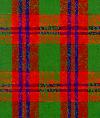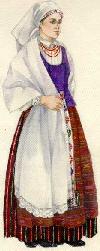NATIONAL COSTUME |
||||
Decorations of womans shirts. Kaišiadorys district. Details of shirt decorated with white embroidery. Cloth of skirt. Varėna district, environs of Marcinkonys. Mid -19th century. Cloth of skirts. Varėna district, environs of Marcinkonys. End of the 19th century. Cloth of skirts. Lazdijai district. 2nd half of the 19th
century. |
The Clothing of Dzūkija Dzūkija is a region whose land consists mostly of poor soils and forests. Because of the poor standard of living there, traditional clothing was worn in many parts of Dzūkija longer than anywhere else in Lithuania, even into the first decades of the twentieth century. Fancy dress worn by villagers varies greatly among the different parts of this region. In the eastern part, clothing is closer to that of Aukštaitija, while in the western part, it shares traits with that of Suvalkija. The woven cloth of garments from Dzūkija is distinguished from that of other regions by its bright colors and smaller checkers and stripes. Earlier women's shirts were sewn and decorated like those in Aukštaitija. They had red woven-in pick-up patterns with a finer texture that was typical of textile decoration in Dzūkija. After the mid-nineteenth century, white work embroidery (broderie anglaise) replaced this older style of decoration. The parts of the shirts that could be seen from under the bodice were embroidered. These included the collar, shoulder tabs, chest and cuffs. Plant patterns, along with this western European embroidery technique, were often changed and reflected the influence of older local geometric ornaments. At the end of the century in Dzūkija it would seem that due to the influence of neighboring Slavic peoples, cross stitches and other similar simple stitches, usually in red and black or white and black, became widespread. Skirts in Dzūkija were usually patterned with fine checkers. It appears that the oldest color combinations in use there were similar to those in Aukštaitija, red and green combinations were enriched with one or two additional colors. Later, the checkers of skirts become finer and new color combinations of dark red and violet appeared. Women from the Užnemunė region of Dzūkija, neighboring the region of Suvalkija, also wore skirts with vertical stripes whose colors were similar to those with checkers. Earlier aprons in Dzūkija were made of linen with white and red or white and blue colored checkers. In the eastern region, bordering Aukštaitija, women wore aprons that were the same as those of women in Aukštaitija women; they were white and decorated with small red stripes at the bottom. In the second half of the nineteenth century, darker aprons, usually finely checkered or striped in red, blue or brown hues came into fashion. These were decorated with horizontally woven stripes of brightly colored wool, and sometimes with finely textured overlayed patterns on the lower edges. In the nineteenth century, women in Dzūkija sewed their bodices for special occasions from purchased cloth (usually silk or wool). Their favorite colors were dark red, green, blue and black. Most typical bodices were sewn with four gradually widening laps, which did not meet in the front. The small space on the waist was left especially for a sash, which remained an important part of clothing in Dzūkija for a long time. Women wore sashes, woven in pick-up paterns, and sometimes more modern overlayed ones. Their geometric ornaments, which were of ancient origin, were usually red, green, blue, or violet in color. As in other ethnographic regions, the most valued women's footwear in Dzūkija was leather shoes. However, fewer people here were able to afford them. Leather soleless shoes (naginės) were also less common than elsewhere. Bast shoes (vyžos) were worn more commonly. Women also wore very unique shoes, the čempės, which were crocheted from thick tow threads decorated with knitting of colored thread. Girls in Dzūkija decorated their heads with crowns and galloons made of ribbons, sashes, and various refinements. Married women wore bonnets, which in Dzūkija were especially varied. They were sewn from linen-netted lace, white or colored cotton, wool and silk. Their front edges were usually decorated with embroidery, various pleated ribbons, laces, beads, and additional shiny ornaments. The decorated side could be seen from under a scarf, which women draped over a bonnet and tied in a knot at the back of the head (and at the end of the nineteenth century, under the chin). Later, bonnets were crocheted from white cotton threads, and in some areas - from colorful wool threads. Married women wore white linen stoles whose ends were decorated with red or blue woven stripes and bobbin laces. Early scarves draped over the shoulders were large and oblong in shape. Much like the linen stoles, they were woven with checkers of two colors. Later, women in Dzūkija began wearing square shawls folded diagonally. In Dzūkija, women's caftans (sermėga) were sewn like in Aukštaitija. They widened at the bottom and were decorated with black velvet or other dark cloth trim and decorative thread. Women here liked coral necklaces. The necklaces were very delicate, and consisted of many strands (up to twenty). The skarinys was a beautiful accessory worn by women in Dzūkija. It was the end of a white linen cloth with long laces, nettled from the end of the warp. Women wrapped small objects they carried with them into this decorative cloth. Men in Dzūkija wore caftans (sermėga) of undyed grey matted woolen cloth. These widened toward the bottom and were decorated with dark trim as well as decorative threads. Long pants were made of the same cloth, from finely checkered grey, brown or dark wool, or of a half-woolen cloth. Due perhaps to the influence of neighboring peoples, men's shirts in the second half of the nineteenth century in Dzūkija were rather densely decorated with white or colored embroidery. Sometimes, they were even sewn with a fastener on the side which was characteristic of Slavic clothing. Men in Dzūkija wore decorative pick-up patterned sashes. Their footwear consisted typically of high or short boots, while the less wealthy wore naginės and vyžos. They also wore "magierka" shape hats as well as other hats, decorated with feathers or flowers. |
Womans costume. District of Kaišiadorys. Mid -19th century. Womans costume. District of Lazdijai. Mid -19th century. Cloth of skirts. Varėna district, environs of Marcinkonys. End of the 19th century. Womans costume. 2nd half of the 19th century. Sashes of Dzūkija. Woman with stole. Environs of Jieznas. Mid -19th century. Skarinys.
|
||
| PREVIOUS | ||||


















